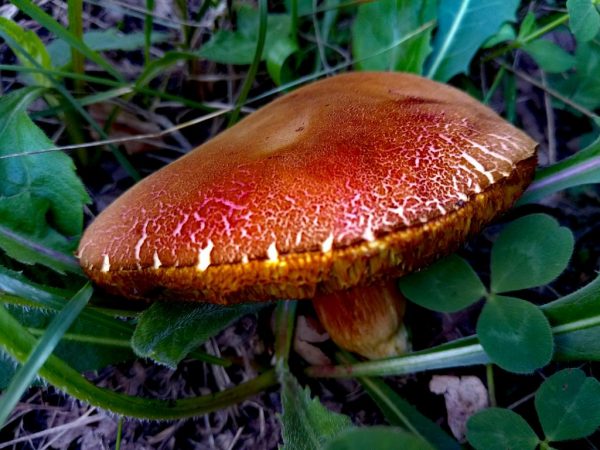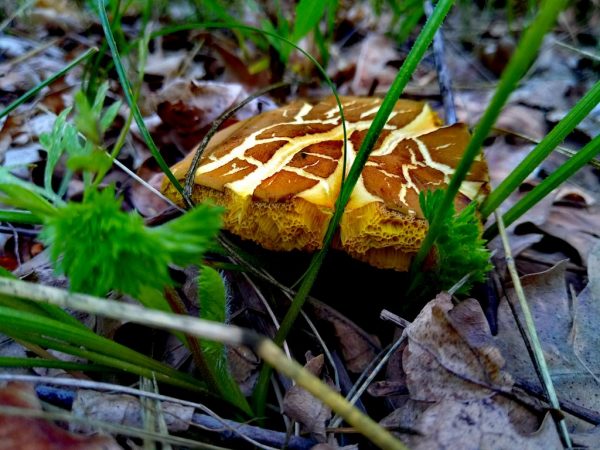Description of the goat mushroom
The goat mushroom is a tubular representative of the higher mushrooms, belonging to the edible varieties and the genus Oiler. Little known to mushroom pickers, the species has good taste, is rich in vitamins and minerals, and easily digestible protein.

Description of the goat mushroom
Description of the mushroom
Goat mushrooms, lattices or undersheets are similar to boletus, especially during rainy weather and their caps are also covered with mucus.
Description of the hat:
- weakly cushion shape;
- skin color is red-brown, light brown with yellowness - depending on weather conditions;
- diameter 4-12 cm;
- the skin protrudes beyond the edge, curls up to a tubular yellow-brown hymenophore.
Leg description:
- cylindrical shape;
- dense, expanding towards the bottom;
- height 3-10 cm, diameter 0.5-2 cm;
- consists of longitudinal fibers;
- the color of the upper part is yellowish, the lower one is brownish with reddishness.
The pulp at the break turns blue or pink under the influence of the external environment. Has a pleasant mushroom aroma. Consists of fibers.
Irina Selyutina (Biologist):
And here are some facts about the goat:
- The flesh of the goat is elastic, springy, not loose. After cooking, it becomes purple in color.
- The goat appears in 1-2 days after the rain. It is at this time that it needs to be collected. If you are late, then about 90% of the mushrooms will already be wormy.
- The goat is a mycorrhizal fungus. Forms mycorrhiza mainly with pine. It is found in pine and spruce (with an admixture of pine) forests.
- It prefers moist acidic soils and is also found in swampy areas.
- Often grows together with pink moss.
False mushroom "kid" does not exist in nature. The goat's twin is a non-poisonous pepper mushroom that is practically not eaten due to its specific peppery taste (as the name implies). Kidney mushroom is often confused with mushrooms and boletus, but since all these species are edible, there is no problem.
Beneficial features
Edible goat mushrooms are included in the 3rd food category. The taste is lower than that of butter, but practically does not differ from the flywheel. The composition includes a number of essential amino acids necessary for the normal functioning of the human body. Among them: tryptophan, glycine, leucine.
Irina Selyutina (Biologist):
The flesh of the goat contains fats, which include lecithin and phosphatides. Among them are the following fatty acids: oleic, linoleic, omega-6, palmitic. Each of them makes its invaluable contribution to the smooth operation of our cardiovascular system. The amount of fat in 100 g of fresh product is 2-3%. For the normal functioning of the digestive system, the goat is a supplier of large amounts of fiber (dietary fiber). The bulk of carbohydrates is represented by glycogen, although there are many mono- and disaccharides. Among the minerals, phosphorus, potassium and calcium occupy a special place. Small amounts of iron and selenium were also found in the legs of the fruit bodies of the goats. The amount of water is 80 g per 100 g of product. The pulp also contains vitamins:
- group B (B1, IN2, IN3, IN5, B9);
- PP;
- D;
- niacin;
- carotene (provitamin A);
- vitamin C.
The calorie content of the goat does not exceed 30 kcal per 100 g of fresh product.
Unlike its other mushroom relatives, the kidney mushroom is well absorbed by the body (almost 70%). It is an irreplaceable source of phosphorus. The goat is ranked among the group of medicinal mushrooms. Possesses bactericidal and antimicrobial effects.
Contraindications
Despite all its usefulness, the goat has contraindications associated with:
- children up to 5-6 years old;
- pregnancy and lactation in women;
- features of the gastrointestinal tract of elderly people.
Attention! Goat mushrooms belong to the protein group of foods that are poorly absorbed by the gastrointestinal tract.
Contraindications to the use of latticework are also associated with the following problems:
- gastroduodenitis;
- kidney disease;
- individual intolerance;
- mold allergies;
- cholelithiasis;
- peptic ulcer, colitis.
For your information. This type of mushroom is not eaten and is not used as a therapeutic agent during the period of taking such drugs:
- antibiotics;
- immunomodulators;
- antiviral;
- insulin;
- pain relievers;
- blood thinning;
- sugar reducing.
Application

Mushrooms improve metabolism
Edible grates are widely used in cooking and medicine. Recommended for a protein diet for those who pursue the goal of gaining muscle mass and "dry" body reliefs. The use of mushrooms improves metabolism.
Regular consumption of mushrooms in normalized quantities improves the state of the nervous and immune systems, has a positive effect on the functioning of the thyroid gland, promotes the regulation of blood pressure, and strengthens the vascular walls.
The substances contained in the pulp of the grate are actively involved in the processes of hematopoiesis, help to remove cholesterol from the body in a natural way.
In cooking
In terms of use in cooking, the goat belongs to the universal varieties of mushrooms. Its taste is most pronounced when dried. The product is preliminarily cleaned of dirt, skins, washed under running water and dried in the sun.
Pickled goat is no less tasty. Before cooking, the mushrooms are peeled, boiled for 20 minutes and the broth is drained. Throw in a colander and allow excess liquid to drain. Then the mushrooms are boiled for 40 minutes in salted water (60 g of salt / kg of mushrooms), with the addition of your favorite spices and vinegar. Poured into glass jars and rolled up.
Before frying, goat mushrooms are boiled for 20 minutes, drained and discarded in a colander, allowing excess liquid to drain. Onion and flour are sautéed in a frying pan until golden brown, mushrooms are poured, spices and sour cream are added. It takes 30 minutes to cook. Boiled young potatoes, rice, or a mixture of vegetables are perfect as a side dish.
In medicine
The mushroom is ideal for obtaining antibiotics and antimycotics. It is also often used to make food supplements.
More widely, the beneficial properties of goat mushrooms are used in alternative medicine. Tinctures with vodka on a goat are used to treat diseases of the musculoskeletal system, to treat wound surfaces.
Dried mushroom, ground into dust, is used as a hemostatic, wound-healing, bactericidal agent. Powder variation is also used to stimulate metabolic processes in the body.
Growing methods
Trees are found in coniferous forests, in swampy areas with well-moistened soil. It is not grown on an industrial scale, since the variety is not very popular even among mushroom pickers, however, those who like to experiment can try to grow a mushroom on their own in their personal plot.
To do this, you need to create conditions that are as close to natural as possible. There should be 4-5 pine trees on the plot. The ideal location is an area with a high level of groundwater.Prepare the place. Stock up on mycelium of mushrooms and spread it over the area. Make sure to maintain constant soil moisture after relocating myceliums.
You will not be able to collect a particularly large harvest, but you will be able to enjoy your own mushroom production. In such a territory, you can plant plants that tolerate high humidity well: cloudberries, viburnum.
Conclusion
Many mushroom pickers bypass edible goats, because they do not know exactly what it is. They have a pronounced odor, neutral taste, and are versatile in terms of use in cooking. There are no false goats. They can only be confused with butter and flywheels.



